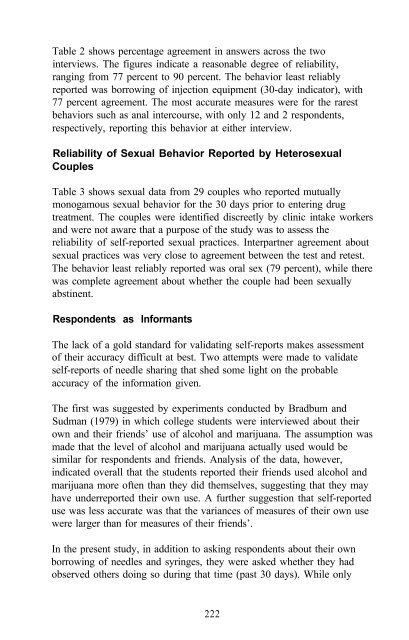The Context of HIV Risk Among Drug Users and Their Sexual Partners
The Context of HIV Risk Among Drug Users and Their Sexual Partners
The Context of HIV Risk Among Drug Users and Their Sexual Partners
You also want an ePaper? Increase the reach of your titles
YUMPU automatically turns print PDFs into web optimized ePapers that Google loves.
Table 2 shows percentage agreement in answers across the two<br />
interviews. <strong>The</strong> figures indicate a reasonable degree <strong>of</strong> reliability,<br />
ranging from 77 percent to 90 percent. <strong>The</strong> behavior least reliably<br />
reported was borrowing <strong>of</strong> injection equipment (30-day indicator), with<br />
77 percent agreement. <strong>The</strong> most accurate measures were for the rarest<br />
behaviors such as anal intercourse, with only 12 <strong>and</strong> 2 respondents,<br />
respectively, reporting this behavior at either interview.<br />
Reliability <strong>of</strong> <strong>Sexual</strong> Behavior Reported by Heterosexual<br />
Couples<br />
Table 3 shows sexual data from 29 couples who reported mutually<br />
monogamous sexual behavior for the 30 days prior to entering drug<br />
treatment. <strong>The</strong> couples were identified discreetly by clinic intake workers<br />
<strong>and</strong> were not aware that a purpose <strong>of</strong> the study was to assess the<br />
reliability <strong>of</strong> self-reported sexual practices. Interpartner agreement about<br />
sexual practices was very close to agreement between the test <strong>and</strong> retest.<br />
<strong>The</strong> behavior least reliably reported was oral sex (79 percent), while there<br />
was complete agreement about whether the couple had been sexually<br />
abstinent.<br />
Respondents as Informants<br />
<strong>The</strong> lack <strong>of</strong> a gold st<strong>and</strong>ard for validating self-reports makes assessment<br />
<strong>of</strong> their accuracy difficult at best. Two attempts were made to validate<br />
self-reports <strong>of</strong> needle sharing that shed some light on the probable<br />
accuracy <strong>of</strong> the information given.<br />
<strong>The</strong> first was suggested by experiments conducted by Bradbum <strong>and</strong><br />
Sudman (1979) in which college students were interviewed about their<br />
own <strong>and</strong> their friends’ use <strong>of</strong> alcohol <strong>and</strong> marijuana. <strong>The</strong> assumption was<br />
made that the level <strong>of</strong> alcohol <strong>and</strong> marijuana actually used would be<br />
similar for respondents <strong>and</strong> friends. Analysis <strong>of</strong> the data, however,<br />
indicated overall that the students reported their friends used alcohol <strong>and</strong><br />
marijuana more <strong>of</strong>ten than they did themselves, suggesting that they may<br />
have underreported their own use. A further suggestion that self-reported<br />
use was less accurate was that the variances <strong>of</strong> measures <strong>of</strong> their own use<br />
were larger than for measures <strong>of</strong> their friends’.<br />
In the present study, in addition to asking respondents about their own<br />
borrowing <strong>of</strong> needles <strong>and</strong> syringes, they were asked whether they had<br />
observed others doing so during that time (past 30 days). While only<br />
222
















